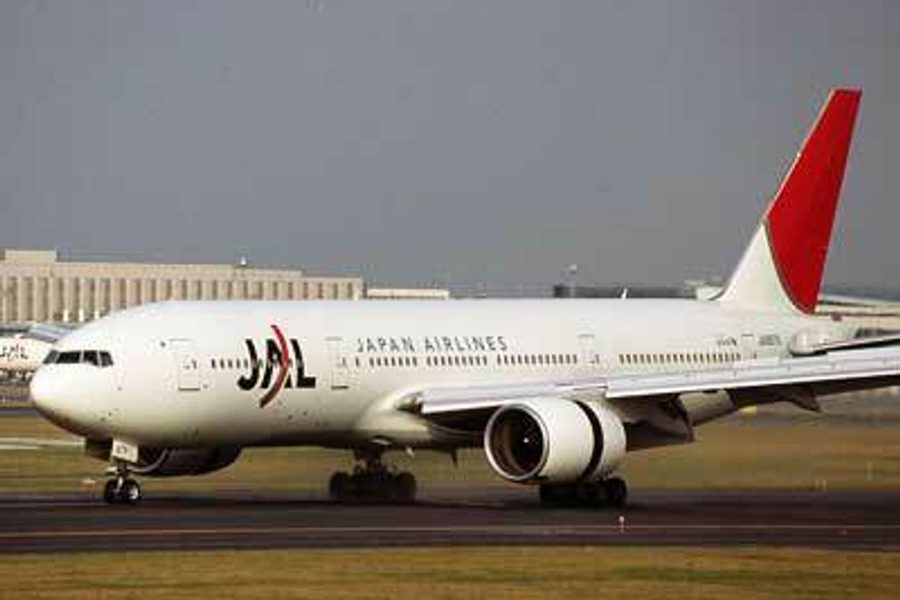
15,700 lay-offs, huge pension concessions roil JAL workforce
These days, it seems like the airline industry can’t catch a break. Faced with in-flight terrorist plots and a recession, airlines are struggling with revenue, security concerns and customer dissatisfaction. And most of all, airline employees have felt the pinch as carriers tighten their budgets.
Those issues have long been growing among U.S. airlines, but now the problem has extended to Japan’s flagship carrier. Last Tuesday, Japan Airlines, Asia’s largest airline by revenue, filed for bankruptcy protection after facing a debt load of over $25 billion. The petition was the largest-ever filing in Japan by a non-financial company and the fourth largest corporate failure.
In a move that largely resembles recent corporate blunders in the U.S., the decision was in preparation for a state-led bailout to undergo massive restructuring. Japanese taxpayers are footing the bill along the way as JAL unions suffer huge setbacks in job losses and benefits.
As one of Japan’s most prominent corporations, JAL once symbolized the country’s postwar rise to a global industrial power. The company first began as a state-led enterprise buttressed by the long-governing Liberal Democratic Party before being privatized in 1987.
But the close relationship with the government ultimately contributed to its downfall. Transportation bureaucrats pushed pork barrel policies that kept unprofitable routes running, and the four government bailouts since 2001 insulated the company from being efficient, further exacerbating the mismanagement. External shocks from September 11th, soaring fuel prices and the global financial crisis also crippled the airliner.
”JAL has always had the protection of the state, so it could put off making hard decisions,” says Motoshige Itoh, an economics professor at the University of Tokyo to the Financial Times. “While big US carriers such as United Airlines, US Airways and Delta Airlines went through court-protected restructurings in the first half of the 2000s, it took the financial crisis and recession to finish off JAL.”
Still, with a “too big to fail” mentality, JAL will continue to keep flying as the company is underwritten once again with government money before it prepares to reorganize. Much like the bailouts of GM in the United States, JAL will receive $10 billion in loans and cash infusions. Other lenders will reportedly provide $8 billion of debt relief.
But workers are taking the biggest hit. As part of the restructuring, the airline will layoff 15,700 employees, roughly one-third of their workforce. Autoworkers and flight attendants in the U.S. have sacrificed their pay and benefits to survive downturns. Similarly, JAL has asked its employees to make enormous concessions. In response, the company’s biggest union agreed to halve their remaining workers’ pensions in order for JAL to receive government funds.
The response resembles what has happened to U.S. unions. Four major U.S. airliners who filed Chapter 11 protections in the wake of the September 11 attacks reworked their labor contracts, according to a report by Demos, a U.S. public policy group.
In the most drastic case, US Airways — during two periods of bankruptcy protection — extracted pay cuts adding up to as much as 40 percent for some employees.
At US Airways and United, tens of thousands of workers were forced to exchange a guaranteed company pension for the drastically reduced protection provided by the federal Pension Benefit Guaranty Corporation. 59 DOT Data for US Airways, United, Delta, American and Northwest show labor costs falling by nearly a third, on average, between the end of 2001 and the beginning of 2006. Hourly wages declined by anywhere from 10 to 25 percent during this period. (The remaining savings came in the form of lost benefits and work-rule changes.)
As In These Times has reported, the decline in wages reflect the larger problem of deteriorating work conditions in the airline industry. Pay levels have gone down, hours have increased and rest breaks have decreased. Put simply, the pilots, flight attendants and mechanics are overworked and underpaid.
That might explain why a pilot mysteriously overshot a landing or a pilot showed up to work inebriated. For consumers, faced with delays, cancellations, erroneous fees and penalties, the quality of air travel has declined.
Those conditions may loom for JAL through its impending reorganization. It is interesting to note how two seemingly divergent, revenue models in the U.S. and Japan have produced the same results, with companies filing bankrupcy and receiving government assistance. While JAL failed despite government subsidies and protections, American airline industries have attempted to reduce costs through deregulation, both with little success.
But whether their economic model hinged on laissez-faire ideology or corporatist state protectionism, JAL’s and U.S. business plans have significantly reduced workers’ pay and benefits.
As JAL seeks an American carrier for a tie-up deal, the U.S. and Japanese airline industries will become more intertwined Hopefully this will be the last of any futher employee cuts. But with grim airline revenue projections, it’s not looking good.







